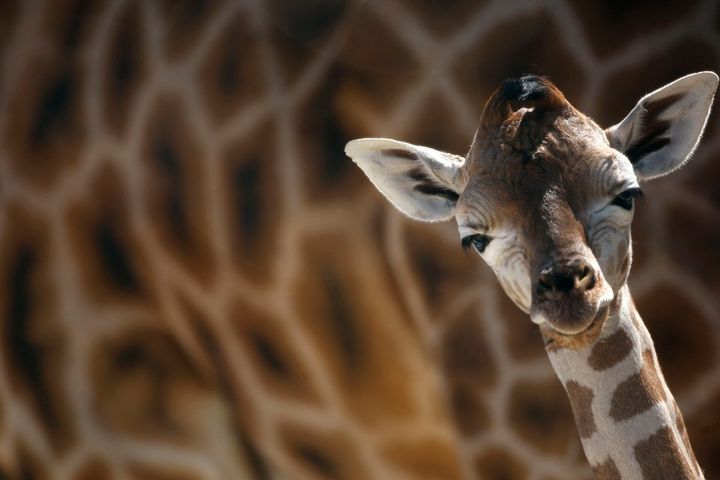
By Ed Yong
The tallest animal in the world is surprisingly inconspicuous. I remember stumbling across one for the first time, as our safari jeep skirted around a random Kenyan bush. There it was. A giraffe. Instantly recognizable, and utterly incongruous in the flesh.
There’s the face — like a camel’s, but more pensive and streamlined. There are the comical tufty horns, the long eyelashes, and the dextrous, purple tongue. There’s that extreme neck, which multi-tasks as a ladder for reaching lofty shoots, a sledgehammer for brutalizing rivals, and a source of dispute for both evolutionary biologists and Fashion Twitter. And there’s the absurd, baffling verticality of the entire creature. J. M. Ledgard put it best in his novel Giraffe: “I am a giraffe, I am about that space a little above the blade, and my bodily intent is to be elevated above all other living things, in defiance of gravity.”
Then there’s the unmistakeable hide. The exact pattern varies between the different subspecies, but all of them feature brown islands separated by criss-crossing white lines. That, coincidentally, is exactly what giraffe habitats are like.
RELATED: A New Origin Story For Dogs
Their homes have become increasingly fragmented by human activity, with once-continuous stretches of forest and savannah broken up by roads and fences. They might be emblems of verticality, but they also roam over great horizontal distances, in search of better and more nutritious food. Constrained by humans, they’re now forced to feed on poorer foliage, leaving them in poorer health. And as different populations become disconnected, each isolated pocket becomes dangerously vulnerable to deforestation, drought, poachers, and troops from war-torn states who see giraffes as military rations. As Jules Howard puts it: “Nine small puddles will evaporate far more quickly than one big puddle, and so it is with life.”
This is a recurring theme in the natural world: Fragmentation brings disaster. It’s as if the cause of the giraffe’s downfall has been painted onto its hide.
In just 30 years, the giraffe population has fallen up to 40 percent, from between 152,000 and 163,000 animals in 1985 to just 98,000 in 2015. This dramatic decline is reflected in the latest edition of the Red List of Threatened Species — the ever-depressing inventory in which the International Union for Conservation of Nature classifies the world’s wildlife into various shades of screwed. Giraffes used to be in the safest bracket: “Least Concern.” As of this week, they’ve been shunted into “Vulnerable” — a two-step demotion, and four steps away from total extinction.
“In just 30 years, the giraffe population has fallen up to 40 percent, from between 152,000 and 163,000 animals in 1985 to just 98,000 in 2015.”
The situation may even be worse than we think, because the Red List treats all giraffes as part of a single species, divided into nine subspecies. But one group of scientists recently found that some of these are genetically distinct enough to count as species in their own right. By their reckoning, there are four species of giraffe, each living in a different part of Africa. Now, those 98,000 individuals have been split into four populations, two of which — the northern and reticulated giraffes — have fewer than 10,000 individuals each.
“Unfortunately, this decline has occurred with little fanfare or public attention,” wrote conservation reporter John Platt in 2014. Conservationists have panicked (quite reasonably) over the fate of the African elephant, but there are five of these mammals for every one giraffe. As I said: The tallest animal in the world is surprisingly inconspicuous. It’s easy to look up at a giraffe, but apparently even easier to look away.
To save the giraffe, people will need to take notice. Niger did so in the 1990s, when there were just 49 giraffes in all of West Africa. In response, the government developed a National Giraffe Conservation Strategy — the first and only one to date. Critically, the strategy involved education: conservationists reached out to local communities and taught them about the giraffe’s perilous state. As a result, the population has since rebounded to 450 and counting, and these giraffes live in peaceful proximity to human villagers.
Kenya is now finalizing a similar strategy, and other countries may follow suit. Specialist organizations like the Giraffe Conservation Foundation are trying to coordinate and boost these efforts. Such coordination is essential, and perhaps even cause for optimism. As Howard writes, “Today’s world contains perhaps the biggest, most spectacular thing that natural selection is capable of producing: coordinated minds that seek to save things other than themselves — the minds of humans, when we’re at our best.”
Perhaps the news of the giraffe’s decline is a fitting end for 2016 — a year in which our own species has repeatedly confronted the specters of isolationism and fragmentation. Perhaps it will take the world’s tallest animal to make us look down at ourselves.
This story originally appeared on TheAtlantic.com.
More from The Atlantic: The Life-Changing Magic of Mushrooms, The Different Stakes of Male and Female Birth Control

